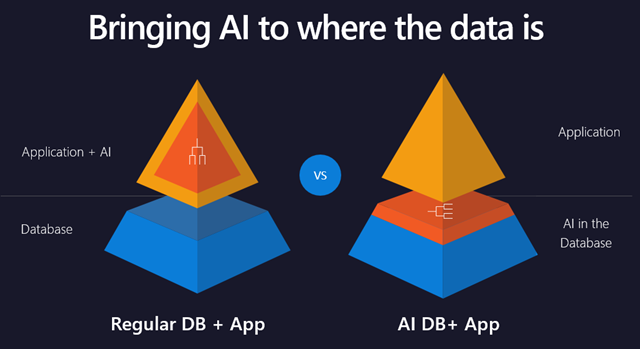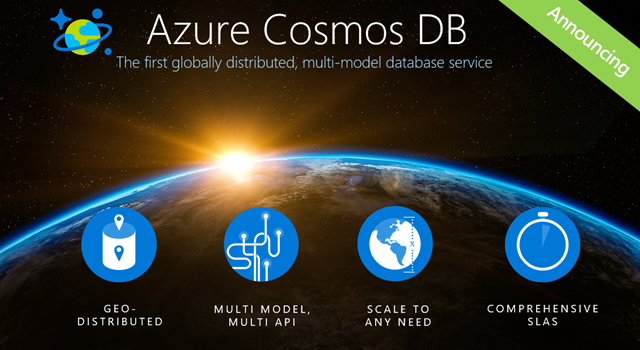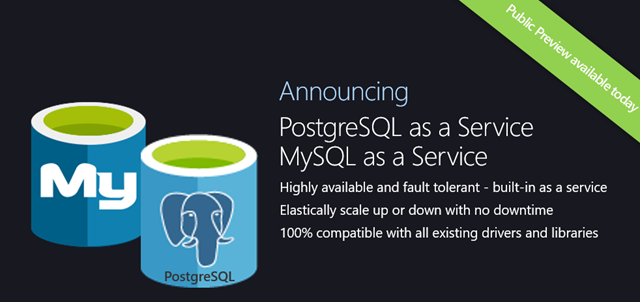Serving AI with data: A summary of Build 2017 data innovations
This post was authored by Joseph Sirosh, Corporate Vice President, Microsoft Data Group
This week at the annual Microsoft Build conference, we are discussing how, more than ever, organizations are relying on developers to create breakthrough experiences. With big data, cloud and AI converging, innovation & disruption is accelerating to a pace never seen before. Data is the key strategic asset at the heart of this convergence. When combined with the limitless computing power of the cloud and new capabilities like Machine Learning and AI, it enables developers to build the next generation of intelligent applications. As a developer, you are looking for faster, easier ways to embrace these converging technologies and transform your app experiences.
Today at Build, we made several product announcements, adding to the recent momentum announced last month at Microsoft Data Amp, that will help empower every organization on the planet with data-driven intelligence. Across these innovations, we are pursuing three key themes:
- Infusing AI within our data platform
- Turnkey global distribution to push intelligence wherever your users are
- Choice of database platforms and tools for developers
Infusing AI within our data platform
 A thread of innovation you will see in our products is the deep integration of AI with data. In the past, a common application pattern was to create machine learning models outside the database in the application layer or in specialty statistical tools, and deploy these models in custom built production systems. This results in a lot of developer heavy lifting, and the development and deployment lifecycle can take months. Our approach dramatically simplifies the deployment of AI by bringing intelligence into existing well-engineered data platforms through a new extensibility model for databases.
A thread of innovation you will see in our products is the deep integration of AI with data. In the past, a common application pattern was to create machine learning models outside the database in the application layer or in specialty statistical tools, and deploy these models in custom built production systems. This results in a lot of developer heavy lifting, and the development and deployment lifecycle can take months. Our approach dramatically simplifies the deployment of AI by bringing intelligence into existing well-engineered data platforms through a new extensibility model for databases.
SQL Server 2017
We started this journey by introducing R support within the SQL Server 2016 release and we are deepening this commitment with the upcoming release of SQL Server 2017. In this release, we have introduced support for a rich library of machine learning functions and introduced Python support to give you more choices across popular languages. SQL Server can also leverage GPU accelerated computing through the Python/R interface to power even the most intensive deep learning jobs on images, text and other unstructured data. Developers can implement GPU accelerated analytics and very sophisticated AI directly in the database server as stored procedures and gain orders of magnitude higher throughput.
Additionally, as data becomes more complex and the relationships across data are many-to-many, developers are looking for easier ways to ingest and manage this data. With SQL Server 2017, we have introduced Graph support to deliver the best of both relational and graph databases in a single product, including the ability to query across all data using a single platform.
We have made it easy for you to try SQL Server with R, Python, and Graph support today whether you are working with C#, Java, Node, PHP, or Ruby.
Azure SQL Database
We’re continuing to simultaneously ship SQL Server 2017 enhancements to Azure SQL Database, so you get consistent programming surface area across on-premises and cloud. Today, I am excited to announce the support for Graph is also coming to Azure SQL Database so you can also get the best of both relational and graph in a single proven service on Azure.
SQL Database is built for developer productivity with most database management tasks built-in. We have also built AI directly into the service itself, making it an intelligent database service. The service runs millions of customer databases, learns, and then adapts to offer customized experiences for each database. With Database Advisor, you can choose to let the service learn your unique patterns and make performance and tuning recommendations or automatically take action on your behalf. Today, I am also excited to announce general availability of Threat Detection, which uses machine learning around the clock to learn, profile and detect anomalous activity over your unique database and sends alerts in minutes so you can take immediate action versus what historically can take an organization days, months, or years to discover.
Also, we are making it even easier for you to move more of your existing SQL Server apps as-is to Azure SQL Database. Today we announced the private preview for a new deployment option within the service, Managed Instance—you get all the managed benefits of SQL Database and now at the instance level which offers support for SQL Agent, three-part names, DBMail, CDC and other instance-level capabilities.
To streamline this migration effort, we also introduced a preview for Azure Database Migration Service that will dramatically accelerate the migration of on-premises third-party and SQL Server databases into Azure SQL Database.
Eric Fleischman, Vice President & Chief Architect from DocuSign notes, “Our transaction volume doubles every year. We wanted the best of what we do in our datacenter…with the best of what Azure could bring to it. For us, we found that Azure SQL Database was the best way to do it. We deploy our SQL Server schema elements into a Managed Instance, and we point the application via connection string change directly over to the Managed Instance. We basically picked up our existing build infrastructure and we’re able to deploy to Azure within a few seconds. It allows us to scale the business very quickly with minimal effort.”
Learn more about our investments in Azure SQL Database in this deeper blog.
Turnkey global distribution to push intelligence wherever your users are
With the intersection of mobile apps, internet of things, cloud and AI, users and data can come from anywhere around the globe. To deliver transformative intelligent apps that support the global nature of modern applications, and the volume, velocity, variety of data, you need more than a relational database, and more than a simple NoSQL database. You need a flexible database that can ingest massive volumes of data and data types, and navigate the challenges of space and time to ensure millisecond performance to any user anywhere on earth. And you want this with simplicity and support for the languages and technologies you know.
 I’m also excited to share that today, Microsoft announced Azure Cosmos DB, the industry’s first globally-distributed, multi-model database service. Azure Cosmos DB was built from the ground up with global distribution and horizontal scale at its core – it offers turn-key global distribution across any number of Azure regions by transparently scaling and distributing your data wherever your users are, worldwide. Azure Cosmos DB leverages the work of Turing award winner Dr. Leslie Lamport, PAXOS algorithm for distributed systems and TLA+ a high-level modeling language. Check out a new interview with Dr. Lamport on Azure Cosmos DB.
I’m also excited to share that today, Microsoft announced Azure Cosmos DB, the industry’s first globally-distributed, multi-model database service. Azure Cosmos DB was built from the ground up with global distribution and horizontal scale at its core – it offers turn-key global distribution across any number of Azure regions by transparently scaling and distributing your data wherever your users are, worldwide. Azure Cosmos DB leverages the work of Turing award winner Dr. Leslie Lamport, PAXOS algorithm for distributed systems and TLA+ a high-level modeling language. Check out a new interview with Dr. Lamport on Azure Cosmos DB.
Azure Cosmos DB started as “Project Florence” in 2010 to address developer the pain-points faced by large scale applications inside Microsoft. Observing that the challenges of building globally distributed apps are not a problem unique to Microsoft, in 2015 we made the first generation of this technology available to Azure developers in the form of Azure DocumentDB. Since that time, we’ve added new features and introduced significant new capabilities. Azure Cosmos DB is the result. It is the next big leap in globally distributed, at scale, cloud databases.
Now, with more innovation and value, Azure Cosmos DB delivers a schema-agnostic database service with turnkey global distribution, support for multiple models across popular NoSQL technologies, elastic scale of throughput and storage, five well-defined consistency models, and financially-backed SLAs across uptime, throughput, consistency, and millisecond latency.
“Domino’s Pizza chose Azure to rebuild their ordering system and a key component in this design is Azure Cosmos DB—delivering the capability to regionally distribute data, to scale easily, and support peak periods which are critical to the business. Their online solution is deployed across multiple regions around the world—even with the global scaling they can also rely on Azure Cosmos DB millisecond load latency and fail over to a completely different country if required.”
Learn more about Azure Cosmos DB in this deeper blog.
Choice of database platforms and tools for developers
We understand that SQL Server isn’t the only database technology developers want to build with. Therefore, I’m excited to share that today we also announced two new relational database services; Azure Database for MySQL and Azure Database for PostgreSQL to join our database services offerings.
 These new services are built on the proven database services platform, which has been powering Azure SQL Database, and offers high availability, data protection and recovery, and scale with minimal downtime—all built-in at no extra cost or configurations. Starting today, you can now develop on MySQL and PostgreSQL database services on Azure. Microsoft is managing the MySQL and PostgreSQL technology you know, love and expect but backed by an enterprise-grade, highly available and fault tolerant cloud services platform that allows you to focus on developing great apps versus management and maintenance.
These new services are built on the proven database services platform, which has been powering Azure SQL Database, and offers high availability, data protection and recovery, and scale with minimal downtime—all built-in at no extra cost or configurations. Starting today, you can now develop on MySQL and PostgreSQL database services on Azure. Microsoft is managing the MySQL and PostgreSQL technology you know, love and expect but backed by an enterprise-grade, highly available and fault tolerant cloud services platform that allows you to focus on developing great apps versus management and maintenance.
“Each month, up to 2 million people turn to the GeekWire website for the latest news on tech innovation. Now, GeekWire is making news itself by migrating its popular WordPress site to the Microsoft Azure platform. Kevin Lisota, Web Developer at GeekWire notes, “The biggest benefit of Azure Database for MySQL will be to have Microsoft manage and back up that resource for us so that we can focus on other aspects of the site. Plus, we will be able to scale up temporarily as traffic surges and then bring it back down when it is not needed. That’s a big deal for us.”
Learn more about these new services and try them today.
Azure Data Lake Tools for Visual Studio Code (VSCode)
Azure Data Lake includes all the capabilities required to make it easy for developers, data scientists, and analysts to store data of any size, shape, and speed, and do all types of processing and analytics across platforms and languages. Additionally, Azure Data Lake includes a set of cognitive capabilities built-in, making it seamless to execute AI over petabytes of data. On our journey to make it easier for every developer to become an AI and data science developer, we are investing in bringing more great tooling for data into the tools you know and love.
Today, I’m excited to announce General Availability of Azure Data Lake Tools for Visual Studio Code (VSCode) which gives developers a light but powerful code editor for big data analytics. The new Azure Data Lake Tools for VSCode supports U-SQL language authoring, scripting, and extensibility with C# to process different types of data and efficiently scale any size of data. The new tooling integrates with Azure Data Lake Analytics for U-SQL job submissions with job output to Azure Data Lake Analytics or Azure Blob Storage. In addition, U-SQL local run service has been added to allow developers to locally validate scripts and test data. Learn more and download these tools today.
Getting started
It has never been easier to get started with the latest advances in the intelligent data platform. We invite you to watch our Microsoft Build 2017 online event for streaming and recorded coverage of these innovations, including SQL Server 2017 on Windows, Linux and Docker; scalable data transformation and intelligence from Azure Cosmos DB, Azure Data Lake Store and Azure Data Lake Analytics; the Azure SQL Database approach to proactive Threat Detection and intelligent database tuning; new Azure Database for MySQL and Azure Database for PostgreSQL. I look forward to a great week at Build and your participation in this exciting journey of infusing AI into every software application.
